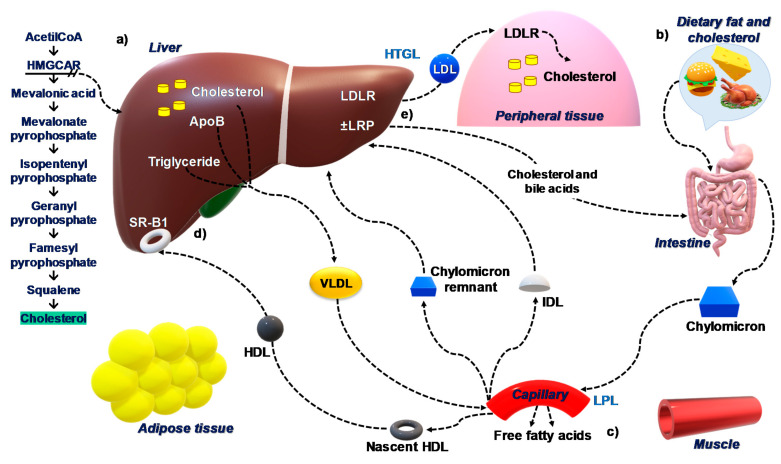Figure 1.
Cholesterol homeostasis in the body. (a) The rate of cholesterol synthesis by the liver is highly dependent on the cellular level of cholesterol and the absorption rate of the small intestine. This feedback regulation is determined predominantly by sterol regulatory element-binding protein-2 (SREBP-2). Subsequently, 3-hydroxy-3-methylglutaryl coenzyme A reductase (HMGCR) catalyzes the formation of mevalonate, the rate-limiting step in cholesterol biosynthesis. (b) Cholesterol and triglycerides from diets are absorbed in the small intestine and are incorporated into chylomicrons. (c) In the plasma, lipoprotein lipase (LPL) acts on chylomicrons to generate fatty acids and chylomicron remnants that are taken up by the liver. The nascent HDL is generated by lipolysis mediated by LPL of lipoproteins rich in triglycerides including VLDL. (d) The concentration of free cholesterol is ”sensed” by SREBP-2 that activates cholesterol synthesis enzyme, HMGCR, when cholesterol content in the hepatocytes is reduced by the import of lipoproteins or is increased by the conversion to bile acids. In addition, SREBP-2 also activates the synthesis of LDL receptors (LDLR), accelerating the uptake of cholesterol from LDL and then promoting the storage of cholesterol in the liver. (e) Conversely, when cholesterol content in the hepatocytes is increased, SREBP-2 is inhibited, leading to LDLR downregulation and inactivation of cholesterol synthesis. Abbreviations: LDLR, low-density lipoprotein receptor; HMGCR, 3-hydroxy-3-methylglutaryl coenzyme A reductase; VLDL, very low-density lipoprotein; HDL-C, low high-density lipoprotein-cholesterol; LPL, lipoprotein lipase; SREBP-2, sterol regulatory element-binding protein-2.

